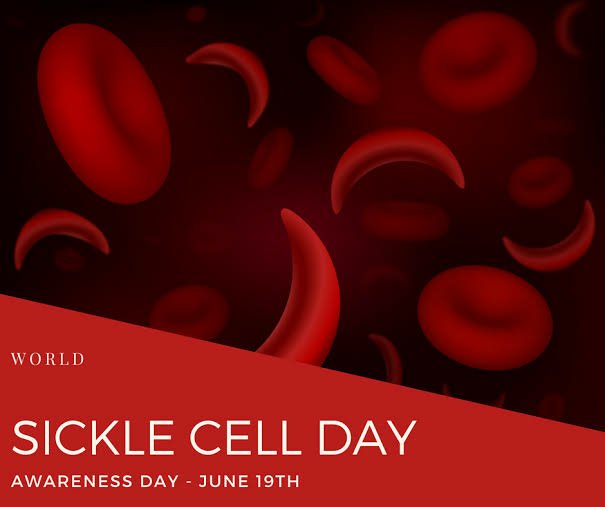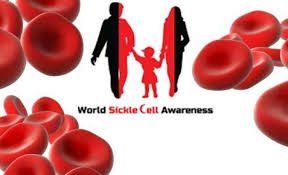Sickle cell disease has been one of the numerous serious health challenges plaguing the world, especially the tropical region. While there are many myths surrounding the disease, most people care very less about it. This has resulted in an increased number of Sickle cell crisis in our hospitals.
The United Nations has set apart June 19 every year to mark the World Sickle Cell in other to create awareness about the disease and also reduce the burden of Sickle Cell Disease in the world.
What Is Sickle Cell Disease?
Sickle cell disease (SCD) is an inherited blood disorder that causes “sickle” shaped red blood cells that can stick together, blocking blood flow and oxygen from reaching all parts of the body.

Let’s Talk About Some Facts About Sickle Cell Disease
- Approximately 5% of the world’s population carries trait genes for haemoglobin disorders, mainly, sickle-cell disease and thalassaemia.
- Haemoglobin disorders are genetic blood diseases due to inheritance of mutant haemoglobin genes from both, generally healthy, parents.
- Over 300 000 babies with severe haemoglobin disorders are born each year.
How Does Sickle Cell Disease Affect Us?
First, let’s understand what haemoglobin is. Let’s look at haemoglobin as a car that helps transport oxygen in the blood.
Haemoglobin is the part of the Red Blood Cell that carries oxygen to every part of the body. When there is an issue with the Transport system, there will be a big problem in those organs where it is supposed to supply.
Now, there are some forms of haemoglobin we have to know.
The normal one is the Haemoglobin A. This makes the red blood cells look the way it is, disc-like in shape. This shape makes it easy for the cells to pass through the narrow blood vessels and it’s also flexible, making it easy for the Red blood cell to permeate through the blood vessels.

We have the abnormal Haemoglobins. Common ones are the Haemoglobin S and Haemoglobin C.
These abnormal Haemoglobins give the Red blood cell a bad shape and thus makes it difficult to pass through the small blood vessels (capillaries). It also loses its flexibility and therefore makes it difficult to pass through the blood vessels. These forms of Haemoglobin are not rare, especially in Nigeria
The Haemoglobin S, in particular, makes the Red Blood Cell have a sickled shape, which makes it difficult to pass through the blood vessels. Imagine a car driving through a narrow road. When the blood can’t pass through the capillaries, it can’t deliver the oxygen and other stuff it’s carrying to that part of the body. That’s where problems arise from the disease.
Another problem with haemoglobin S is, it has a shorter life span. Thus, the Red blood cells destroy faster than normal and that is a big problem because:
- These destroyed RBC go to the spleen and stay there.
- It causes overproduction of bilirubin which can make the eyes turn yellow.
The Haemoglobin S also makes the blood become more viscous and thick, making it easy to clump together and occlude tiny blood vessels leading to sickle cell crisis.

How Can Someone Get This Disease?
Sickle Cell Disease is a genetic disorder and can be inherited easily.
Basically, there are 3 common genotypes: AA, AS and SS.
The letters signify that an offspring have to a gene a trait from both parents. So a person can inherit a gene from the father and inherit another gene from the mother. It obeys the Mendelian Laws of inheritance
Other uncommon ones includes the AC, SC, etc.
Let’s explain how we get those genotypes.
People with AA genotype have a normal genotype and have no issues.
People with AS genotype are called carriers. Most times, they don’t show any symptoms but they can transfer the gene to their offsprings.
People with SS genotype are called people with Sickle Cell Disease. They show all the symptoms explained earlier. They inherit haemoglobin S genes from their parents and don’t usually live a comfortable life.
Which Genotype Is Compatible And Why?
In most countries of the world, genotype testing before marriage is mandatory so as to prevent the birth of more people with Sickle Cell Disease and reduce the burden worldwide.
A child who inherits two of the same genes, one from each parent, will be born with the disease. However, a child of two carriers has only a 25% chance of receiving both S genes and developing the disease, and a 50% chance of being a carrier.

Most carriers lead completely normal, healthy lives.
AA father + AS mother =
This these people have the probability of having AA and AS children in a ratio of 50:50 or 1:1.
They’re safe to get married because they’ll have normal and Carrier children
AA + SS=
These people can get married. All their children will be Carriers (AS).
AS + AS =
Cannot marry because there’s a possibility of having a child with SS trait. These people can’t get married.
AS + SS =
is a No-No. Chances are worse here. A probability of 50% of having a child with Sickle Cell Disease.
SS + SS=
They shouldn’t even be seen together.
Signs And Symptoms Of Sickle Cell Disease
Sickle-cell disease is characterized by a modification in the shape of the red blood cell from a smooth, doughnut shape to a crescent or half-moon The misshaped cells lack plasticity and can block small blood vessels, impairing blood flow.
This condition leads to shortened red blood cell survival, and subsequent anaemia, often called sickle-cell anaemia. Poor blood oxygen levels and blood vessel blockages in people with sickle-cell disease can lead to chronic acute pain syndromes, severe bacterial infections, and necrosis (tissue death).
These blood clots can cause extreme pain in the back, chest, hands and feet because the blood doesn’t flow well to those regions.
The disrupted blood flow can also cause damage to bones, muscles and organs.
People with sickle cell disease often feel weak, tired and look pale. The whites of the eyes and skin often have a yellowish tint.
Environmental factors often play a role in the occurrence of painful attacks. Common triggers include cold temperatures, dehydration, excessive amounts of exercise and tobacco smoke. Other triggers such as plane flights and high altitudes can also trigger an attack.

Management Of Those With Sickle Cell Disease
Haemoglobin disorders can be effectively reduced through a strategic balance of disease management and prevention programmes.
Sickle-cell disease can be managed by simple procedures including:
- High fluid intake
- Healthy diet
- Folic acid supplementation
- Pain medication
- Vaccination and antibiotics for the prevention and treatment of infections
- and a number of other therapeutic measures.
In Summary:
The most cost-effective strategy for reducing the burden of haemoglobin disorders is to complement disease management with prevention programmes. Inexpensive and reliable blood tests can identify couples at risk of having affected children. This screening is especially opportune before marriage or pregnancy, allowing couples to discuss the health of their family. Subsequent genetic counselling informs trait carriers of risks that the condition may be passed along to their children, the treatment needed, if affected by a haemoglobin disorder, and the possible options for the couple. Prenatal screening of genetic diseases raises specific ethical, legal and social issues that require appropriate consideration.


